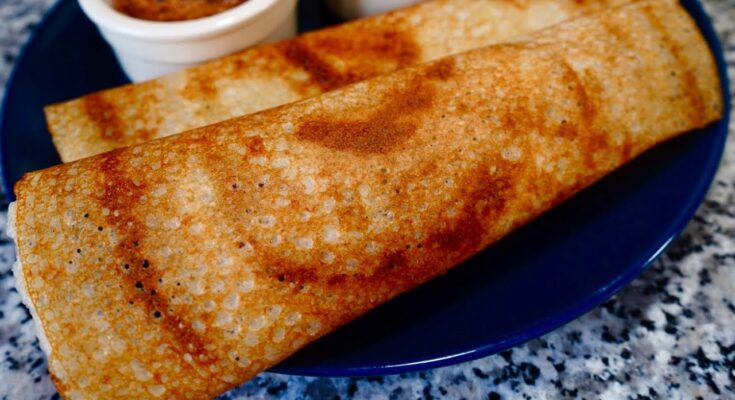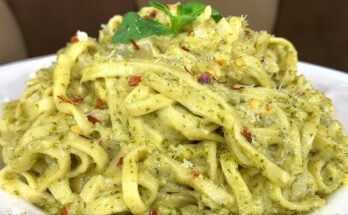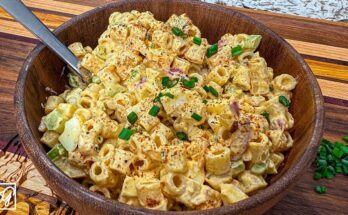Dosa Recipe: Dosa is one of the most iconic dishes in South Indian cuisine. Think of it as India’s answer to the crepe — but so much more than just a thin pancake. Made from fermented rice and urad dal (black gram), dosa is a savory, crispy delight that has found fans across the globe. What makes dosa truly unique is its texture — soft and spongy on the inside and beautifully crisp on the outside. It’s light yet filling, simple yet flavorful. This beloved dish can be eaten for breakfast, lunch, or dinner. Whether you enjoy it plain or stuffed with spicy masala, dosa is always a treat.
Origin and Cultural Importance
Dosa dates back over 2,000 years, with its origins rooted in Southern India — particularly the states of Tamil Nadu and Karnataka. Over time, it has become a staple not just in the South but throughout the entire country. Each region adds its own twist to dosa: Mysore masala dosa, set dosa, neer dosa, and more. It’s more than just food — it’s comfort on a plate. Dosa is also significant in Indian vegetarian diets, offering a nutritious meal rich in carbohydrates and protein, especially when paired with chutneys or sambar. It’s a dish served in temples, street stalls, and five-star hotels alike.
Ingredients Needed for Making Dosa
Essential Ingredients
To make the classic dosa, you’ll need just a few pantry staples. These core ingredients are:
- Parboiled rice – 2 cups
- Urad dal (split black gram) – ½ cup
- Fenugreek seeds – 1 tsp
- Salt – to taste
- Water – for soaking and grinding
- Oil or ghee – for cooking the dosa
These ingredients form the base of a traditional dosa batter. The urad dal helps the batter ferment and adds a fluffy texture, while fenugreek aids fermentation and gives that mild tang.
Optional Ingredients for Variations
Want to experiment or add some nutrition? Try these:
- Chana dal – for added crispiness
- Flattened rice (poha) – makes dosas softer
- Cooked rice – for extra softness
- Quinoa or millets – for a healthier twist
- Onions, green chilies, curry leaves – for onion dosa or spiced versions
These variations allow you to customize your dosa to match your taste or dietary preferences. Whether you like your dosa thin and crispy or thick and fluffy, adjusting these ingredients can help you get it just right.
Preparing the Dosa Batter
Washing and Soaking Rice and Dal
This is one of the most critical steps. Start by washing your rice and dal separately under cold water until the water runs clear. This helps get rid of excess starch and impurities. Soak the rice and fenugreek seeds together in a bowl, and urad dal separately in another bowl. Let them soak for at least 4–6 hours or overnight. This softens them, making grinding easier and ensures a smooth batter texture.
Grinding the Batter
Once soaked, it’s time to grind. Use a wet grinder or a high-powered blender. Start with the urad dal – add it into the grinder with some water and grind it until it’s fluffy and light (usually 20-25 minutes in a wet grinder, less in a blender). Transfer to a large bowl. Now grind the soaked rice and fenugreek with water until it’s smooth but still slightly grainy. Combine both mixtures in a big bowl or vessel. Add salt and mix well.
Ensure the batter has a flowing consistency – not too thick or too watery. It should coat the back of a spoon.
Fermentation Process
Fermentation is the magic step. Leave your batter in a warm, dark place to ferment for 8 to 12 hours, depending on the weather. In warm climates, it may only take 6–8 hours. You’ll know it’s fermented when the batter has doubled in size and smells mildly tangy.
Tip: In colder months, leave the batter near a heater or inside the oven with the light on. If needed, wrap the bowl in a towel to trap heat.
Making the Perfect Dosa
Heating the Pan Properly
Use a cast iron tawa or a non-stick skillet. Heat it on medium-high until it’s hot but not smoking. To test, sprinkle a few drops of water – they should sizzle and evaporate immediately. Lightly grease the pan with oil and wipe it clean with a half-cut onion or paper towel. This helps prevent sticking and adds a subtle flavor.
Pouring and Spreading the Batter
Pour a ladleful of batter in the center of the pan. Using the bottom of the ladle, quickly spiral outwards in a circular motion to spread it thin. If you’re new, it might take a few tries to get the swirl right — but practice makes perfect. Drizzle a little oil or ghee around the edges and on top. Cook until the edges start lifting and the bottom turns golden brown.
For crispier dosa, let it cook a little longer. You can either fold it in half or roll it like a cone before serving.
Achieving the Right Texture and Crispiness
The trick to that perfect crispy dosa lies in the batter consistency and the heat of the pan. A well-fermented batter + medium-high heat = dosa perfection. Make sure the pan isn’t too greasy or too cold — both can ruin the texture. Clean the tawa between each dosa using the onion or a cloth to maintain consistency.
Serving Suggestions
Best Chutneys to Pair with Dosa
What’s dosa without a killer chutney on the side, right? These accompaniments take your dosa experience to the next level. Here are some top chutney picks that pair like a dream:
- Coconut Chutney – The most classic option. Made from grated coconut, green chilies, roasted chana dal, and a touch of ginger, this chutney is creamy, mildly spicy, and incredibly fresh.
- Tomato Chutney – Slightly tangy and vibrant. Tomatoes, onions, garlic, and red chilies are sautéed and blended for a bold flavor that contrasts beautifully with the dosa’s crispiness.
- Mint-Coriander Chutney – A refreshing green chutney bursting with herbs. It adds a zingy punch and is super easy to whip up.
- Peanut Chutney – Especially popular in Andhra Pradesh, this rich, nutty chutney is perfect for those who want something a little different.
For an extra layer of taste, most South Indian households do a tadka (tempering) on top of the chutney using mustard seeds, curry leaves, and dried red chilies. It enhances both aroma and taste.
Popular Side Dishes like Sambar
Apart from chutneys, sambar is another must-have on the dosa plate. This hearty lentil-based stew is packed with vegetables, tamarind, and a medley of South Indian spices. It’s not just tasty — it’s healthy and filling too.
Here’s why sambar works so well with dosa:
- The warm, soupy texture balances the crispiness of the dosa.
- The tanginess of the tamarind adds a flavor burst.
- Packed with protein and fiber from lentils and vegetables.
You can also try:
- Potato Masala – A spiced mashed potato curry usually stuffed inside the dosa for a classic masala dosa.
- Chili-Garlic Chutney – For those who like it fiery.
- Gunpowder (Milagai Podi) – A dry, spicy powder made with lentils and red chilies. Mix it with sesame oil or ghee for a flavorful dip.
Serving dosa is all about variety. Mix and match chutneys and sambar to create your perfect dosa platter. Whether it’s a cozy weekend breakfast or a full-blown South Indian feast, the right sides turn dosa into a complete and satisfying meal.
Tips and Tricks for Dosa Perfection
Consistency of Batter
The consistency of your dosa batter is key to nailing the texture. If your batter is too thick, you’ll end up with a chunky, uneven dosa that doesn’t spread well. On the flip side, if it’s too watery, it won’t hold shape and will become soggy. The ideal dosa batter should be like a flowing pancake batter — thick enough to coat the ladle but thin enough to spread easily on the pan.
- Add water gradually during grinding.
- After fermentation, give the batter a good stir before making dosas.
- If the batter seems too thick, you can add a splash of water to thin it out.
Keep a check on the weather — warm temperatures accelerate fermentation, while cold ones may slow it down. A pro tip: slightly under-fermented batter can still be used by adding a spoon of yogurt or a pinch of baking soda to give it a quick lift.
Choosing the Right Cookware
A traditional cast iron tawa gives the best results — crispy edges and that authentic flavor. But if you’re new or want a hassle-free experience, a non-stick pan works too. The key is even heating. Here’s what to keep in mind:
- Ensure the pan is seasoned properly if you’re using cast iron.
- Avoid overheating — it can make the batter stick.
- Always wipe the pan between dosas to remove any residue and maintain a smooth surface.
A well-maintained tawa or skillet is a dosa-maker’s best friend.
Popular Dosa Variants You Must Try
Masala Dosa
Arguably the most famous version of dosa. It’s stuffed with a spicy potato filling made with boiled potatoes, onions, mustard seeds, curry leaves, and turmeric. The crispy outer shell and the soft, flavorful filling make every bite irresistible. Served with coconut chutney and sambar, it’s a full meal on its own.
Rava Dosa
Unlike traditional dosa, rava dosa is made instantly with semolina (rava), rice flour, and all-purpose flour. No soaking, grinding, or fermenting required! It’s super thin, lacy, and crisp, often spiced with onions, green chilies, and cumin seeds. Perfect when you’re short on time but craving something delicious.
Set Dosa
These are soft, spongy, and slightly thick — usually served in a stack of three. Set dosa is made with a slightly different ratio of rice and urad dal and is fermented longer. Best paired with vegetable saagu or kurma.
Neer Dosa
A delicacy from coastal Karnataka, neer dosa is made with only soaked rice and water. It’s thin, delicate, and white, served with coconut chutney or sweet jaggery-coconut mixture.
Health Benefits of Eating Dosa
Dosa isn’t just delicious — it’s pretty good for you too. Thanks to fermentation, dosa becomes more digestible and rich in probiotics, which support gut health. Here’s a look at why dosa can be a healthy choice:
- Rich in Carbohydrates and Protein – Gives energy and supports muscle health.
- Low in Fat – Especially if you cook it with minimal oil or opt for non-stick pans.
- Good for Digestion – The fermented batter improves nutrient absorption.
- Gluten-Free – Ideal for those with gluten sensitivity (if made without wheat or semolina).
- Customizable – Add vegetables, millets, or use brown rice for extra nutrition.
Just go easy on the oil or butter if you’re watching calories. And remember, moderation is key!
FAQs about Dosa Recipe
1. How long can dosa batter last in the fridge?
Dosa batter can last for up to 4–5 days in the refrigerator. Just stir well before using and add a little water if it thickens.
2. Can I skip fermentation to make dosa instantly?
You can try using instant dosa mixes or make rava dosa, which doesn’t require fermentation. However, traditional dosa needs fermentation for the right flavor and texture.
3. Why does my dosa stick to the pan?
This usually happens if the pan isn’t hot enough or hasn’t been seasoned properly. Wiping the tawa with a cut onion helps prevent sticking.
4. Can I make dosa without urad dal?
Yes, but the texture will be different. You can substitute with moong dal, toor dal, or even try dosa with just rice for a variation.
5. What’s the best way to make dosa crispy?
Use a well-fermented batter, ensure the tawa is hot, spread the batter thinly, and drizzle oil or ghee around the edges while cooking.
Conclusion
Making dosa at home is more than just cooking — it’s a labor of love. From soaking and grinding the ingredients to fermenting the batter and finally cooking it to golden perfection, each step brings you closer to an authentic taste of South India. With a few basic ingredients and a bit of patience, you can recreate this culinary masterpiece in your own kitchen. Whether you enjoy it plain, with spicy chutneys, or stuffed with masala, dosa is a timeless dish that never disappoints. Once you master the basics, the possibilities are endless. So grab your ladle, heat that tawa, and start your dosa journey today!



